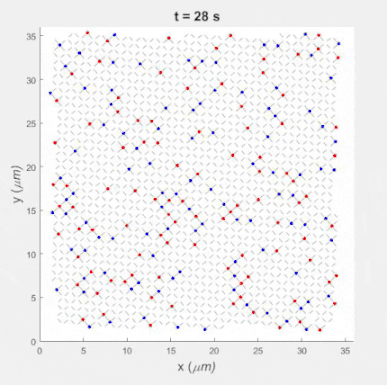Mar 5 2019
Headed by the Department of Energy’s Lawrence Berkeley National Laboratory (Berkeley Lab), a research team has developed a nanoscale “playground” on a chip that mimics the formation of monopoles—a group of exotic magnetic particles.
 Magnetic monopoles in motion at 210 K. Red dots represent positive magnetic charges (north poles), while blue dots represent negative magnetic charges (south poles). (Image credit: Farhan/Berkeley Lab)
Magnetic monopoles in motion at 210 K. Red dots represent positive magnetic charges (north poles), while blue dots represent negative magnetic charges (south poles). (Image credit: Farhan/Berkeley Lab)
Recently reported in Science Advances, the study can possibly unravel the secrets to more powerful and ever-smaller microelectronics, memory devices, and state-of-the-art hard drives that utilize the power of magnetic spin for storing data.
Follow the “ice rules”
Other scientists have long been attempting to develop a real-world model of a magnetic monopole—a hypothetical subatomic, magnetic particle possessing one south or north pole. Simulation and visualization of these elusive particles can be achieved by producing artificial spin ice materials, which are huge arrays of nanomagnets having structures similar to water ice, in which the atoms are not perfectly arranged in a symmetrical fashion, resulting in residual south or north poles.
In magnetism, opposites always attract (that is, south poles are drawn to north poles, and vice-versa), and hence single poles like these try to move to locate their perfect match. However, the monopoles are extremely confined, because traditional artificial spin ices are 2D systems and are thus not realistic representations of the way magnetic monopoles behave, stated study lead author Alan Farhan, who was a former postdoctoral fellow at Berkeley Lab’s Advanced Light Source (ALS) during the study, and is currently with the Paul Scherrer Institute in Switzerland.
In order to overcome this barrier, the team headed by the Berkeley Lab replicated a nanoscale 3D system that obeys “ice rules”—a principle that controls the way atoms organize themselves in ice created from the mineral pyrochlore, or water.
This is a crucial element of our work. With our 3D system, a north monopole or south monopole can move wherever it wants to go, interacting with other particles in its environment like an isolated magnetic charge would—in other words, like a monopole.
Alan Farhan, Study Lead Author, Paul Scherrer Institute
A nanoworld on a chip
Advanced lithography tools devised at Berkeley Lab’s Molecular Foundry—a nanoscale science research facility—were used by the researchers to pattern a three-dimensional (3D), square lattice of nanomagnets. Within the lattice, each magnet is roughly the size of a bacterium, resting on a flat, 1 x 1 cm silicon wafer.
“It’s a nanoworld—with tiny architecture on a tiny wafer,” but atomically configured exactly like natural ice, stated Farhan.
In order to develop the nanostructure, the team created a couple of exposures, each one aligned within 20 to 30 nm. Scott Dhuey, the co-author of the study, developed nanopatterns of four kinds of structures onto a small silicon chip, at the Molecular Foundry. At the ALS, a synchrotron light source research facility open to global visiting researchers, the chips were subsequently analyzed.
Using a technique known as X-ray photoemission electron microscopy (PEEM), the researchers directed intense beams of X-ray light, which is responsive to magnetic structures at the nanopatterns, to visualize the way monopoles may form and move in response to temperature changes.
Contrary to PEEM microscopes at other kinds of light sources, the PEEM3 microscope of Berkeley Lab possesses a higher X-ray angle of incidence, reducing shadow effects—analogous to the shadows cast by a building as soon as the sun hits the surface at a specific angle.
In fact, the images recorded reveal no shadow effect whatsoever. This makes the PEEM3 the most crucial element to this project’s success.
Alan Farhan, Study Lead Author, Paul Scherrer Institute
Farhan informed that the PEEM3 is the world’s only microscope that offers users complete temperature control in the sub-100 K (below –280 °F) range. This device has the ability to capture in real time the way emergent magnetic monopoles form when artificial frozen ice melts into a liquid, and when liquid fizzles into a gas-like state of magnetic charges—a form of matter called plasma.
Currently, the investigators are planning to pattern increasingly smaller nanomagnets for the development of tinier yet more robust spintronics—a popular field of microelectronics that taps into the magnetic spin properties of particles for storing more amounts of data in smaller devices like magnetic hard drives.
Devices like these would utilize superconducting thin films and magnetic films to deploy and control magnetic monopoles to sort and store data on the basis of the south or north direction of their poles—similar to the zeros and ones in traditional magnetic storage devices.
The Molecular Foundry and the ALS are DOE Office of Science user facilities. The U.S. Department of Energy’s Office of Science and the Swiss National Science Foundation supported the study.